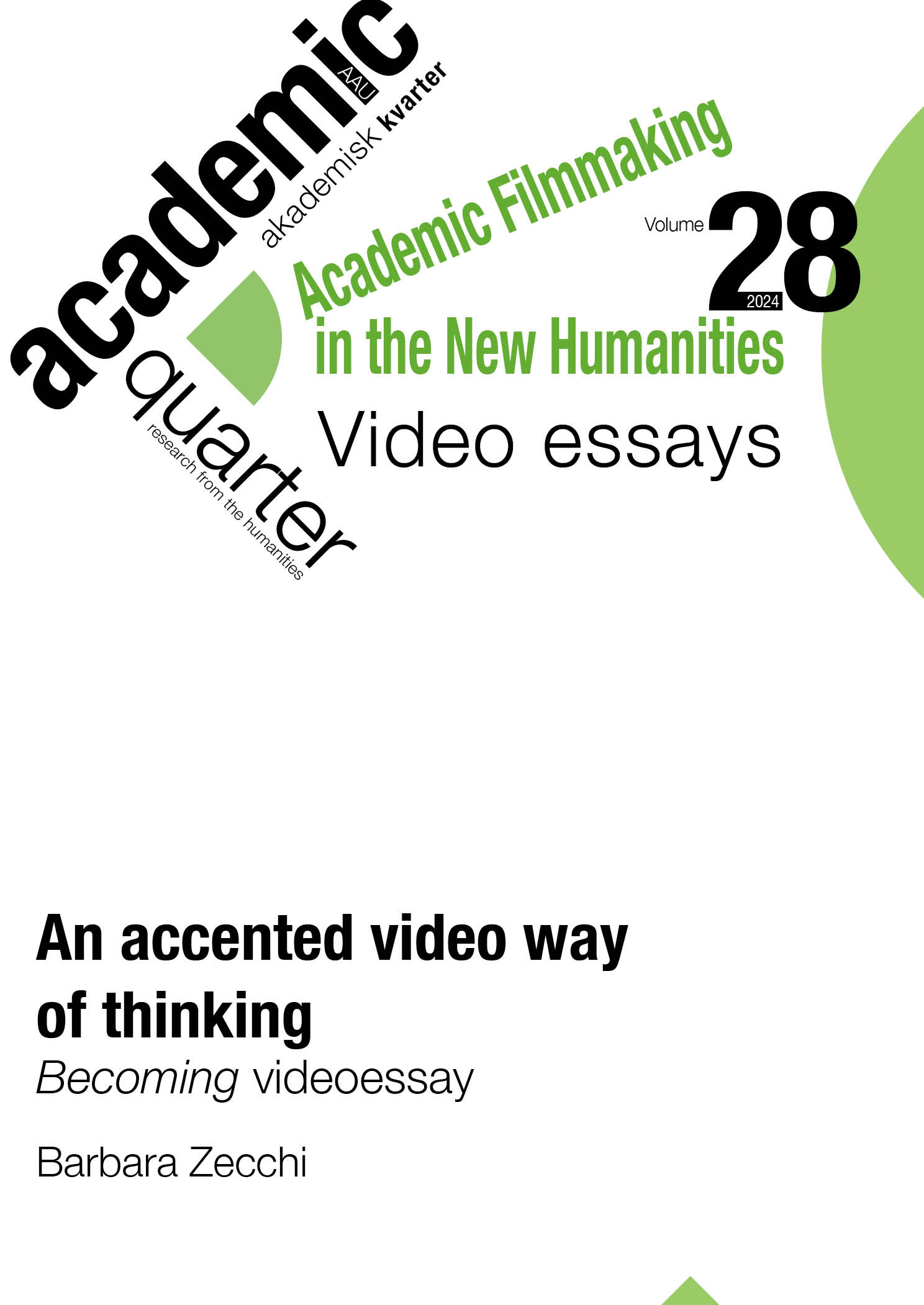Abstract | Abstract
“An accented video way of thinking: Becoming videoessay” explores the videoessay as a conceivably “accented” form. (I prefer the spelling “videoessay” —a sort of accented choice, given that it echoes the Spanish “videoensayo”— to better convey a sense of seamless integration between video and essay.) In Thinking with an Accent, Pooja Rangan et al. (2023) argue that the accent should be understood not as a way of speaking but as a mode of thought. Two decades earlier, in Accented Cinema, Hamid Naficy used the term “accented” to describe a mode of film production that shapes filmmakers’ “feelings as thought” into an alternative “accented style” (2001, 26). Expanding on these ideas, I propose to consider the position of the videoessay in relation to traditional (i.e. accent-less) scholarship, its imperfect mode of production, and the affective engagement of the “cinephiliac” videoessayist with the media object (Keathley 2000, Grant 2014, 2016). By foregrounding the accented nature of the videoessay form, I suggest that the videoessay represents not only a “video way of thinking”, as Spatz (2018) has indicated, but an accented video way of thinking. In Deleuzian terms, I propose that the videoessay, as an accented practice and epistemology, uses the transforming force of “becoming” (devenir) (1994a, 1994b) to redefine the boundaries and the discourses of the supposedly “accentless” film and media scholarship, thus “deterritorializing” it to make it accented. Through three different segments, not meant to be watched in any specific order, I explore the accented dimensions of the videoessay’s sound (the echo, the stutter, the index of unbelonging, the simulacrum), surface (the haptic shudder, the textural affect-driven style), and thought (the becoming minoritarian, the shifting of the maker) toward a counter-hegemonic onto-epistemology of videographic criticism.
Referencer
Binotto, Johannes. 2020. “In Lag of Knowledge. Videoessay as Parapraxis.” In Practical Aesthetics, edited by Bernd Herzogenrath,
-93. London, New York: Bloomsbury. https://doi.org/10.5040/9781350116139.0011
Braidotti, Rosi. 1993. “Embodiment, Sexual Difference, and the Nomadic Subject.” Hypatia 8 (1): 1-13. https://doi.org/10.1111/j.1527-2001.1993.tb00625.x
Braidotti, Rosi. 2014a. “Thinking with an Accent: Françoise Collin, Les cahiers du Grif, and French Feminism.” Signs 39 (3): 597–626. https://doi.org/10.1086/674299
Braidotti, Rosi. 2014b. “Writing as a Nomadic Subject” Comparative Critical Studies 11 (2–3): 163–184, Edinburgh University Press. https://doi.org/10.3366/ccs.2014.0122
Bruno, Giuliana. 2014. Surface: Matters of Aesthetics, Materiality, and Media. Chicago: University of Chicago Press. https://doi.org/10.7208/chicago/9780226114835.001.0001
Deleuze, Gilles. 1994. “He Stuttered.” In Gilles Deleuze and the Theater of Philosophy, edited by Constantin V. Boundas and Dorothea Olkowski, 23-29. London: Routledge.
Deleuze, Gilles. 1994a. Difference and repetition. New York: Columbia University Press.
Deleuze, Gilles. 1994b. What Is Philosophy? New York: Columbia University Press.
Deleuze, Gilles, and Felix Guattari. 1987. A Thousand Plateaus: Capitalism and Schizophrenia. University of Minnesota Press.
Fanon, Frantz. 1952. Black Skin, White Masks. Éditions du Seuil. Translated in 1967. Grove Press.
Ferguson, Kevin L. 2017. “Digital Surrealism: Visualizing Walt Disney Animation Studios,” Digital Humanities Quarterly 11 (1). https://www.digitalhumanities.org/dhq/vol/11/1/000276/000276.html
Fowler, Catherine. 2021. “Expanding the field of practice-based-research: the videographic (feminist) diptych.” Media Practice and Education, 22 (1): 49-60. https://doi.org/10.1080/25741136.2021.1832770
Garwood, Ian. 2016. “The Place of Voiceover in Academic Audiovisual Film and Television Criticism.” NECSUS European Journal of Media Studies (Autumn 2016). https://necsus-ejms.org/the-place-of-voiceover-in-audiovisual-film-and-television-criticism/
Grant, Catherine. 2014. “The Shudder of a Cinephiliac Idea? Videographic Film Studies Practice as Material Thinking.” ANIKI: Portuguese Journal of the Moving Image 1 (1). https://doi.org/10.14591/aniki.v1n1.59
Grant, Catherine. 2016. “How long is a piece of string? On the Practice, Scope and Value of Videographic Film Studies and Criticism.” The Audiovisual Essay: Practice and Theory of Videographic Film and Moving Image Studies, September 2014. http://reframe.sussex.ac.uk/audiovisualessay/frankfurt-papers/catherine-grant/
Grenoble, Lenore A. 2021. “Language Shift.” Linguistics, March 25, 2021. https://doi.org/10.1093/acrefore/9780199384655.013.347
Keathley, Christian. 2000. “The Cinephiliac Moment.” Framework, 42. https://8ba99043-46ef-443e-8e66-bc36ac01fd7b.filesusr.com/ugd/32cb69_3ba21383aae34be5a6869fe8e4342f84.pdf
Massumi, Brian. 1995. “The Autonomy of Affect” Cultural Critique 31, The Politics of Systems and Environments, Part II, 83-109. https://doi.org/10.2307/1354446
Mittel, Jason. 2021. “Deformin’ in the Rain: How (and Why) to Break a Classic Film.” Digital Humanities Quarterly 15 (1). https://www.digitalhumanities.org/dhq/vol/15/1/000521/000521.html
Naficy, Hamid. 2001. An Accented Cinema: Exilic and Diasporic Filmmaking. Princeton University Press.
O’Leary, Alan. 2023. “Nebular Epistemics: A Glossary (Scholarship Like a Spider or Spit)”. Zeitschrift für Medienwissenschaft, ZfM, Videography, 12. https://zfmedienwissenschaft.de/online/videography-blog/nebular-epistemics
Rangan, Poojar, Akshya Saxena, Ragini Tharoor Srinivasan, and Pavitra Sundar, eds. 2023. Thinking with an Accent: Toward a New Object, Method, and Practice. University of California Press. https://doi.org/10.1525/luminos.148
Spatz, Ben. 2018. “The Video Way of Thinking.” South African Theatre Journal, 31 (1): 146–154. https://doi.org/10.1080/10137548.2017.1414629
Stam, Robert. 2000. “Beyond Fidelity: The Dialogics of Adaptation.” In Film Adaption, edited by James Naremore, 54-76. New Brunswick, N.J: Rutgers University Press.
Williams, Raymond. 2015. “Structures of Feeling.” In Structures of Feelings: Affectivity and the Study of Culture, edited by Devika Sharma and Frederik Tygstrup, 20-26. Berlin, München, Boston: De Gruyter.
Zecchi, Barbara. 2019. What is an Accented Videoessay? Video, 03:54. Uploaded to Vimeo March 13, 2021. https://vimeo.com/523317867
Zecchi, Barbara. 2022. Empowering the Accent in Videographic Criticism. An Accented Videoessay. Video, 08:08. Uploaded to Vimeo February 22, 2022. https://vimeo.com/680718777
Zecchi, Barbara. 2023. “The Accented Sound of Camp.” Zeitschrift für Medienwissenschaft, ZfM, Videography, 12 (2) Politics. https://zfmedienwissenschaft.de/en/online/videography-blog/accented-sound-of-camp

Dette værk er under følgende licens Creative Commons Navngivelse – Ikke-kommerciel – Ingen Bearbejdede Værker (by-nc-nd).
Copyright (c) 2024 Barbara Zecchi
